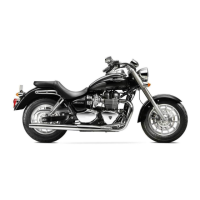
Do you have a question about the Triumph 900 Cruisers and is the answer not in the manual?
| Brand | Triumph |
|---|---|
| Model | 900 Cruisers |
| Category | Motorcycle |
| Language | English |
Explains warning, caution, and note symbols used in the handbook.
Details warning labels on the motorcycle and their meaning.
Advises on using authorized dealers for motorcycle maintenance.
Warns against tampering with the noise control system.
Explains the purpose and recommendations for using the owner's handbook.
Encourages customer feedback on the ownership experience.
States information is based on latest data and Triumph reserves the right to change it.
Details motorcycle usage, load limits, and off-road/trailer restrictions.
Provides warnings about gasoline flammability and exhaust fume toxicity.
Covers safe riding practices, licensing, and defensive riding.
Emphasizes wearing protective gear like helmets, gloves, and appropriate clothing.
Explains motorcycle weave and wobble phenomena and how to handle them.
Advises on maintaining control using handlebars and footrests.
Details safe parking procedures and precautions.
Warns about using only approved parts and accessories for safety.
Stresses consulting dealers for doubts and ensuring equipment is lawful.
Points to warning labels on the motorcycle and their related handbook information.
Continues detailing warning label locations on the motorcycle.
Identifies major parts of the motorcycle with numerical labels.
Continues identifying motorcycle parts with numerical labels.
Identifies controls on handlebars and dashboard with numerical labels.
Shows location and method for identifying the VIN.
Shows location and method for identifying the engine serial number.
Details the motorcycle's instrument panel features and indicators.
Provides information on fuel types and grades for the motorcycle.
Lists and describes various indicator lights and gauges on the instrument panel.
Explains the function of the speedometer and its display.
Describes the odometer and trip meter functions and how to use them.
Explains how to adjust the motorcycle's clock display.
Describes the tachometer function and its red zone warning.
Explains the meaning and function of various warning lights on the instrument panel.
Details the ignition key, its tag, and spare key management.
Explains the location and operation of the ignition switch.
Describes the function of each ignition switch position (OFF, ON, PARK).
Details the steering lock key and its function.
Explains how to engage and disengage the steering lock.
Identifies and explains the function of right handlebar switches (engine stop, starter).
Explains the function of the starter button and its operation.
Identifies and explains left handlebar switches (headlight dimmer, turn signal, horn).
Describes how to adjust brake and clutch levers for comfort.
Specifies the required octane rating and types of unleaded gasoline.
Explains the use of oxygenated gasoline and potential effects.
Details the use of ethanol blends in the motorcycle.
States the permitted level of MTBE in gasoline.
Warns against using fuels containing methanol due to potential damage.
Provides safety instructions and precautions for refuelling the motorcycle.
Explains how to open and close the fuel tank cap.
Details how to fill the fuel tank safely and avoid overfilling.
Explains that the right side cover is not normally removed by the owner.
Advises on how to clean and care for the seat cover to prevent damage.
Instructs to ensure the side stand is fully up before riding and warns about interlock system.
Explains where the owner's handbook is stored on the motorcycle.
Provides guidelines for the breaking-in period of a new motorcycle.
Details daily safety checks required before riding the motorcycle.
Lists essential daily checks to ensure safe and reliable operation.
Provides steps on how to properly stop the motorcycle's engine.
Outlines the procedure for starting the motorcycle's engine.
Explains how to move off and shift gears safely and efficiently.
Warns about potential engine overheating during prolonged idling or slow riding.
Advises on the proper use of the starter motor to prevent overheating.
Details the procedure for starting off and changing gears, including warnings.
Provides essential information and warnings about motorcycle braking techniques.
Discusses braking on steep gradients, engine braking, and coasting.
Details proper methods and precautions for parking the motorcycle.
Discusses important factors and warnings for operating the motorcycle at high speeds.
Advises checking steering for smooth operation and cable clearance.
Recommends securing luggage properly before riding.
Reminds to check front and rear brakes are functioning properly.
Emphasizes tire condition and pressure for high-speed riding.
Notes the need for sufficient fuel due to higher consumption at high speeds.
Advises checking engine oil level and grade.
Reminds to check all lights, horn, etc.
Advises checking fasteners and safety-related parts.
Warns that accessories and weight affect handling, stability, and speed.
Details risks of incorrect loading, distribution, and securing of loads.
Instructs passengers on proper posture, holding, and leaning for safety.
Prohibits carrying animals due to unpredictable movements.
States passenger must be tall enough to reach footrests for stability.
Warns against storing items that could restrict steering, causing loss of control.
Sets limits and precautions for carrying small objects on the passenger seat.
Outlines the importance of scheduled maintenance and refers to the chart.
Covers engine oil inspection, change, and specification.
Details tire maintenance, including inflation, wear, and replacement.
Covers battery maintenance, charging, and storage precautions.
Explains fuse location, identification, and replacement procedures.
Details headlight adjustment and bulb replacement procedures.
Covers brake, tail, license plate, and turn signal bulb replacement.
Provides guidelines for cleaning the motorcycle, including specific parts and precautions.
Details the schedule and procedures for regular motorcycle servicing.
Presents a chart detailing maintenance operations and their intervals.
Covers brake pad inspection, fluid levels, light switches, and fluid replacement.
Explains how to record scheduled maintenance in the service handbook.
Introduces engine oil maintenance, levels, and function.
Describes how to check the engine oil level using the sight glass.
Details the procedure for changing the engine oil and oil filter.
Explains how to remove and install a new oil filter.
Advises on the proper and environmentally safe disposal of used oil and filters.
Specifies the correct type and grade of engine oil to use.
Covers inspection of the throttle grip for smooth operation and free play.
Explains how to adjust throttle cables for correct free play.
Explains clutch operation and the importance of checking lever free play.
Details how to check and adjust clutch cable free play for correct operation.
Emphasizes checking, adjusting, and lubricating the drive chain.
Details the frequency and method for lubricating the drive chain.
Explains how to measure and check the drive chain's free movement.
Details how to adjust the drive chain slack and wheel alignment.
Describes how to inspect the drive chain for wear and damage.
Details how to inspect sprockets for wear and damage.
Covers inspection and replacement of brake pads and discs.
Explains how to inspect brake pad lining thickness for wear.
Notes that brake pad wear is automatically compensated.
Explains checking brake light switch function for safety.
Details brake fluid inspection, replacement, and type.
Guides on checking and adjusting front brake fluid level.
Guides on checking and adjusting rear brake fluid level.
Covers inspection and lubrication of steering head and wheel bearings.
Details how to inspect steering head bearings for proper function.
Explains how to check for free play in the steering.
Describes how to inspect wheel bearings for play, noise, or smooth operation.
Notes that front suspension is non-adjustable and provides inspection details.
Explains how to adjust rear suspension spring pre-load.
Provides suggested rear suspension pre-load settings for different load conditions.
Shows typical tire and wheel markings.
Details correct tire inflation pressures and when to check them.
Advises on tire wear and not using tires worn to their minimum.
Specifies minimum tread depth and when to replace tires.
Advises on using approved tires and having them installed by a dealer.
Warns about using incorrect tires or weights, and the need for proper seating.
Covers battery warnings, disposal, and general precautions.
Instructs on the proper disposal of used motorcycle batteries.
Provides step-by-step instructions for removing the motorcycle battery.
Details cleaning battery terminals and cautions about battery acid.
Advises on checking and charging the battery during storage or infrequent use.
Provides guidance on selecting battery chargers and charging procedures.
Provides instructions for correctly installing the motorcycle battery.
Explains the location of fuses and how to access them.
Details how to replace blown fuses with the correct rating.
Explains how to identify fuses using numbers and a table.
Details headlight adjustment for horizontal and vertical beam settings.
Explains how to adjust the headlight's horizontal beam position.
Explains how to adjust the headlight's vertical beam position.
Provides instructions for replacing headlight and position light bulbs.
Explains how to replace the brake, tail, and license plate light bulbs.
Details how to replace turn signal light bulbs.
Emphasizes regular cleaning for motorcycle appearance and preservation.
Lists precautions to take before washing to protect components.
Highlights areas to avoid spraying water with force during washing.
Advises on cleaning the seat using mild soap and water.
Guides on cleaning unpainted aluminum parts with specific cleaners.
Details how to clean the exhaust system, including washing and drying.
Recommends applying protective products to the exhaust system.
Explains how to clean windshields and when replacement is needed.
Details steps for preparing the motorcycle for storage, including fuel and engine oil.
Outlines steps to take when taking the motorcycle out of storage.
Lists performance specifications like maximum power and torque.
Provides key dimensional data for the motorcycle.
Details engine specifications like type, displacement, bore, and stroke.
Lists lubrication system type and engine oil capacity guidelines.
Details fuel system type, pump, and pressure.
Specifies fuel type and tank capacity.
Details ignition system type, spark plug, and gap.
Lists transmission types, ratios, and drive details.
Specifies correct tire inflation pressures for front and rear tires.
Lists available tire options and manufacturers.
Lists specifications for battery, alternator, lights, etc.
Lists key tightening torque values for various components.
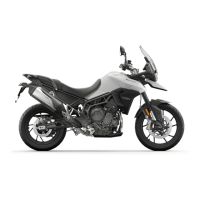
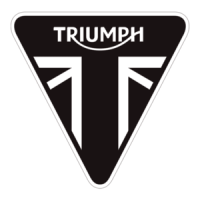


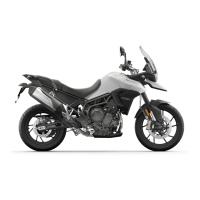
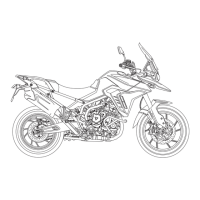


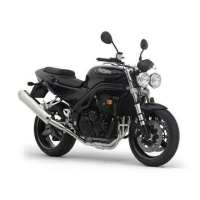
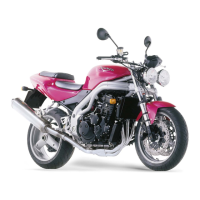

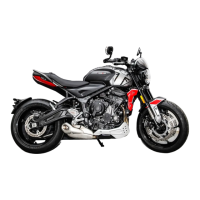
